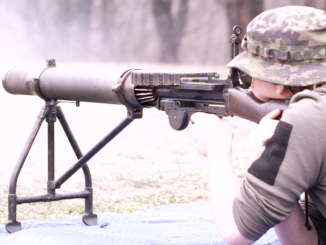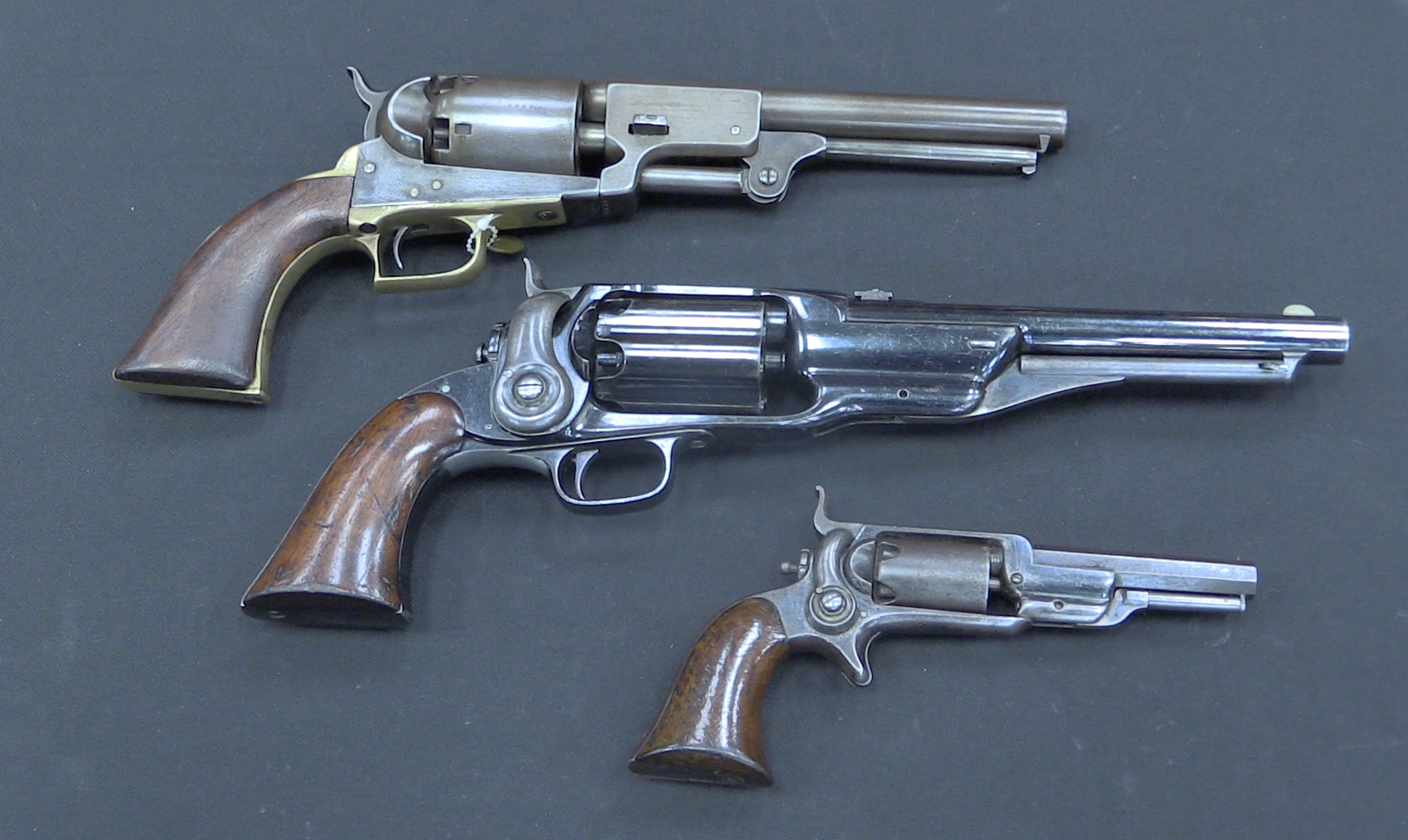The Walch revolver was a Civil War era design with the unique feature of having superimposed loads – each chamber in the cylinder held not one shot, but two, stacked one on top of the other. The revolver had two hammers and a progressive trigger, and 10 percussions caps (for the 5-chamber model). This led to a 10-shot revolver in the size of a typical 5-shot one. Of course, since the chambers were split between two powder charges, the muzzle velocity was relatively low in comparison to other revolvers of the period.
This Walch 10-shot .31 caliber example has been modified by someone into a pepperbox style of pistol, with the barrel completely removed. This makes it substantially more compact, but also amplifies the problem of low muzzle velocity, and without any rifled bore at all, I’m sure accuracy suffers as well. Not that this was intended for use at any significant distance, of course…




Here we go again with the Mark Twain references to inaccurate early revolvers and pepper boxes, now with a dangerous side-dish of cylinder detonation should the superposed priming system suffer catastrophic malfunction. Just like the Lindsay Double Musket’s usage, I suspect that smart users would only put in one load per barrel. Or if we assume that the cylinder won’t detonate if a flash over occurs between the powder loads, the worst place one could stand would be “GET YOUR MITTS OFF ME” range in front of the pepper box.
If I’ve messed up, SAY SOMETHING!!!!!
“(…)now with a dangerous side-dish of cylinder detonation should the superposed priming system suffer catastrophic malfunction. Just like the Lindsay Double Musket’s usage,(…)”
I am not sure, would detonation of both loads rip cylinder? Chain-fire which sometime happens in percussion revolvers might activate only front loads.
If the back load fires first for any chamber (meaning that someone loaded two rounds per chamber and pulled the “rear” hammer back first), the rear bullet will be forced against a load of powder and another bullet that’s been rammed into that chamber (and that bullet in the front may have paper wadding applied to it to prevent it from falling out the barrel. If that’s the case, the gas from the burning powder will seek the easiest way out-through the percussion cap nipple and INTO YOUR FACE. And if my assumption about 19th Century metallurgy is correct, the cylinder will also suffer permanent damage. Remember the issue of chain fire for the Colt revolving rifled musket? The test firing went wrong and the cylinder EXPLODED.
Have I messed up again?
“The test firing went wrong and the cylinder EXPLODED”
But was that design flaw XOR manufacturing flaw?
Anyway, the danger of firing multiple loads at once, seems to menace weapons using superposed loads. In times when only alternative to get multiple shots without reloading was using multiple barrels it might have get some success, but with invention of single-barrel repeating weapons, superposed loads fallen in oblivion.
This concept was later used by Metal Storm in their weapons, which is working, but so far I know don’t enjoy big commercial success (or I am wrong?)
is: “(…)superposed loads(…)”
should be: “(…)superposed loads since its introduction(…)”
However, I think superposed load idea can be used in rail rocket launcher, that is mounting several rocket on rail (not tube, see РО-82 for example, 2nd photo from top here: http://www.airwar.ru/weapon/anur/rs82-132.html ) and using special rocket with two-stage engine: “cold” starting engine and normal engine for rest of flight (to avoid activation of following rocket)
Okay, the Colt revolving rifle’s failure was due to manufacturing problems (including tolerances, primitive metallurgy, and maintenance) and inherent design flaws (gas leakage and lack of research into whether or not concept of percussion revolver works with Minie balls). Back in those days, the only way to see if your revolver would work right was to load up an overcharged cylinder and then remotely pull the trigger (by trip wire). If the cylinder didn’t explode, you were probably fine.
Metal Storm works, but it’s only good for the military as even the pistol form of the concept is too costly for self-defense/police purposes (needs batteries and expensive proprietary ammunition).
Anything wrong with the claims?
Well, I don’t know how vulnerable the shooter’s face would be, given that there’d be little point in trying to aim a pepperbox like that. Firing from the hip would be far more likely. It’d be no fun getting your hand scorched by a backfire, but I think your face and eyes would be at a safe distance.
18th and 19th illustrations almost invariably show shooters sticking the gun out there at arm’s length. Hip shooting takes a lot of practice. Acting like you’re pointing your finger with a straight arm actually gets hits even if you ignore old revilvers’ rudimentary sights. This does leave your face pointed at any arm that exploded
“amplifies the problem of low muzzle velocity, and without any rifled bore at all, I’m sure accuracy suffers as well”
On the other hand for second load of each chamber, forward part of chamber act like (unrifled) barrel
IF the a hammer was damaged, maybe the barrel was too, and the motivation was to get some use out of a broken gun.
The “inspiration” for this (if that’s the right word) was likely a French pepperbox with six barrels that also used superposed loads to result in a 12-shot “high-capacity” weapon. It’s illustrated and described in the “Superposed Loads” chapter of Firearms Curiosa by Lewis Winans.
And yes, if the rear load is fired first, I would expect both a “blown primer” (percussion cap) and a burst chamber at least. The most likely result of the blown cap would be forcing the hammer back to full cock, or even breaking it.
It could, however, be even nastier. In one case George Nonte related, the firing pin bushing came out of a Colt M1873 at the beginning of a five-shot string on a range. The unsupported primer blew out, the gases forced the hammer back far enough to raise the hand, but not far enough to engage the half-cock safety notch. The hammer then fell again (the revolver apparently also had a worn quarter-cock interceptor notch) and fired the next round.
Result? The world’s first, and so far only, “full-auto” Peacemaker. For five shots, anyway.
NB; There is now a special “pepperbox” version of the Colt M1851 on the market from EMF;
http://www.emf-company.com/store/pc/1851-Navy-Pepperbox-c527.htm
Fortunately, it’s strictly a “six-shooter”.
cheers
eon
Superimposed load firearms such as this could be safe. They really shouldn’t have more than two loads and just need to be built and proofed at a level where a double load is established to be safe and then also loaded with care and ideally have lockwork that obstructs firing the rear chamber. A lot of arms were proof tested with a double load anyway. It wouldn’t have the same safety margin but it’s not as unsafe as it would seem at first glance.